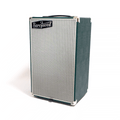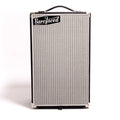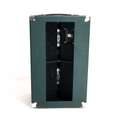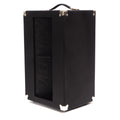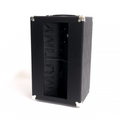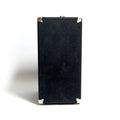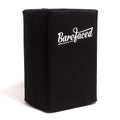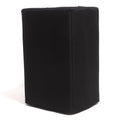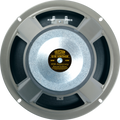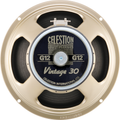Mutiny 210V / 112V
Regular price
£399.00
£749.00
The Mutiny 210V combines the 2x10" format of the Usurper 210H with the full-height AVD of the Uprising 212V to give a big open tone that fills a room with more air and less thickness. Great for bringing out those rhythm guitar mids that so many tens do well!
The name came from it being a skunkworks experiment by our factory manager and production supervisor, who rotated the Usurper’s 210 enclosure to the vertical, gave it a double AVD and it just sounded right straight away!
This isn't one to sit under big heads - it's only 15" / 38cm wide. But it's ideal under lunchbox heads or as a pedalboard driven solution.
We also offer a custom 1x12" version of this cabinet, the Usurper 112V, for guitarists who want a taller narrower version of our Reformer 112 for an even smaller footprint on tight stages.
The AVD uses the rearward cone output to generate and disperse additional broadband output to fill the room with tone.
As standard it’s loaded with two Celestion G10 Vintage loudspeakers, giving 120W power handling and buckets of authentic tone. But if your sonic preference differs, you can customise it with a selection of guitar drivers, or even have it unloaded!
Barefaced Mutiny 210V / 112V Guitar Loudspeaker Cabinet
All prices include shipping to wherever you are in the world - select your region to see the correct price for you!
Current time to dispatch? Click here to check our production lead times page!
Specifications
| Stock 210 - G10 Vintage | Custom 210 - Min/Alt | |
| Dimensions (H x W x D) |
61cm x 38cm x 31cm 24" x 15" x 12" |
|
| Weight | 11 kg / 24 lbs | 9 kg / 21 lbs (Ten30) |
| Drivers | Celestion G10 Vintage | Four other Celestion tens to choose from |
| Enclosure design | AVD+ | |
| RMS power handling | 120 Watts | 60W RMS (Greenback/Ten30) |
| Nominal Impedance | 16 ohm | (4 or 8 ohm also available) |
Features
- Innovative internal design - Barefaced AVD enclosure for superior audibility, efficiency and power handling
- Low-cut filter toggle switch
- Choose from a selection of Celestion 10" speakers. The iconic Celestion G10 Vintage fitted as standard.*
- Either a black or silver cloth grill with white piping.
- British Raging Green or Black in Black tolex.
- Single top strap handle
- Rubber feet on base and side
- Dual combi 1/4” + speakon sockets
*Additional customisation fee applies. See below.
Questions
Traditional guitar loudspeaker designs.
There are basically two sorts - closed-back and open-backed. Open-backed because they were combos and needed to keep the valves cool and accessible for servicing, closed-back and sealed because that’s how most speakers were made in the 1960s.
How does that affect using them?
The closed-back cabs have narrowing dispersion as frequency increases (a hi-fi speaker uses smaller speakers for higher frequencies to reduce this problem). The open-backed cabs fire sound out of the back as well as the front, so although the dispersion narrows from both front and back in much the same way as the closed-back cab, the sound coming out of the back helps fill the room with mids and highs - but that sound out of the back cancels out most of the lows (due to the inverted phase as the back of the speaker pulls when the front pushes and vice versa). In other words, open-back cabs are easier to hear around the room but the lows are thinner.
How is the Usurper 210 different?
From the front it behaves much like a closed or open-backed cab. But the mids and highs coming out of the AVD at the back are amplified and dispersed around the room whilst the lows are inverted to match the lows from the front, giving lots more bottom. Basically you get twice the output of a closed back cab with an identical speaker AND even better dispersion and audibility (and far far greater output) than an open-backed cab.
What is AVD?
You see it when you look at the back of the cab - it’s the Augmented Vent Diffractor. It’s a unique patended technology that we started developing back in 2013. At low frequencies the AVD and the separate tube port act as tuned vents or Helmholtz resonators, improving efficiency, power handling and output. At mid and high frequencies the AVD acts to diffract, disperse and couple the sound with the room for improved audibility and output especially in rooms with poor acoustics.
What is the Lo Cut filter for?
The increased low frequency output from the AVD may be too much for some guitarists’ tastes - so you can flick this switch and remove lows at the cab. Doing so not only changes the bass response but also increases the power handling of the cab, lowers the distortion due to motor excursion and reduces the load on your amp’s output stage. This can give you two different sweet-spots of optimum speaker overdrive or break-up and two different sweet-spots of power valve overdrive. If your sound is perfect in rehearsal but too dirty at a louder gig then engaging the Lo Cut filter will clean it up.




















